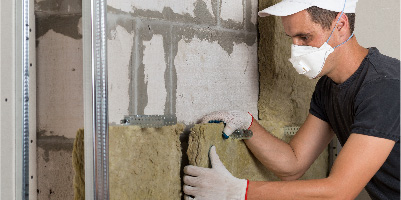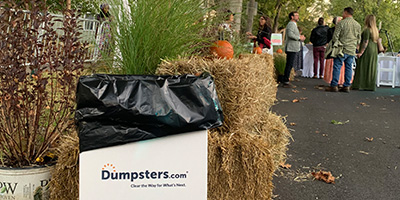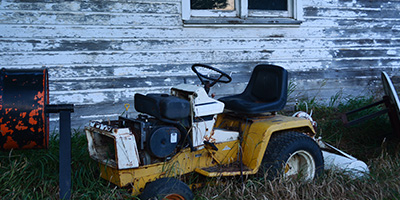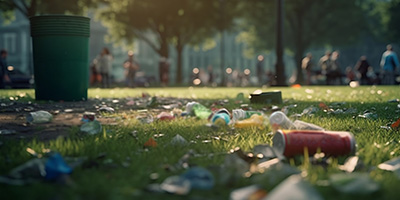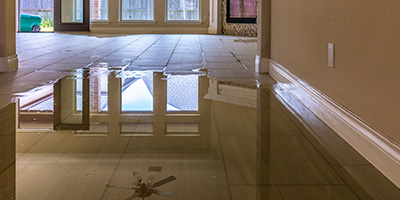Your Guide to Cleaning Up After a House Fire
Returning to your house after a fire is difficult, so we've created a guide to help ease the process.
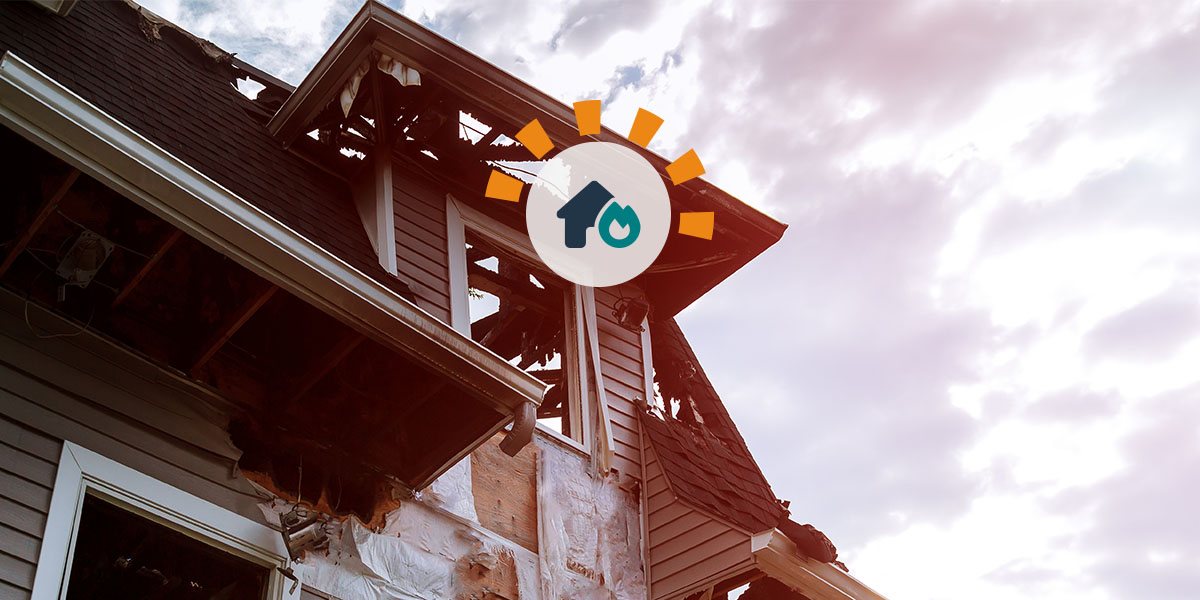
How to Clean After a Fire in Your Home
Dealing with the realities of life after a home fire is emotional and stressful. We know there’s a lot to think about, so we’ve gathered some tips to help you clean up and get back on your feet. Use the following checklist to figure out how to clean dishes after a small grease fire or how to clean your home’s exterior after a more serious situation.
House Fire Cleaning FAQs
Is it safe to use dishes after a house fire?
If your dishes were made from plastic or wood, it is probably best to throw them out. Any other materials are perfectly safe to use as long as they have been thoroughly cleaned.
What should be thrown away after a fire?
Anything that was openly exposed to any chemicals used by firefighters is probably best to be thrown away. Perishable food or any food that is not sealed may possess health risks if not disposed of.
Is it safe to clean up after a house fire?
It depends on the impact the fire had on your home. Even if it seems like minimal damage, cleaning up after a fire can be very dangerous. Contact someone with proper training who can assess the home before you begin tidying up.
What to Do After a House Fire
From making sure your house is structurally safe to figuring out what can be salvaged, here’s what you need to do to clean out your house after a fire.
Inspect the Home and Assess Damage
It’s important to have a professional take a look at your home before you set foot inside and attempt to clean, paint or fix any damage. Aside from obvious structural issues, your home could have suffered hidden damage to electrical wiring, wall supports, the foundation, the roof, the deck, the porch or the entrance to your house during the fire.
While having a professional assess any dangers, make sure to file a claim with your insurance company and have an insurance representative take a look at the damage. They may also be able to provide you with a list of professionals who can help you with cleanup and recovery.

“Typically, the first step is to have the fire department confirm there are no hazards leftover from the fire or the possibility of a blaze restarting. This way, you can toss damaged items without worrying about a dumpster fire. You can even toss construction debris burned by the flames, like drywall and plywood.”
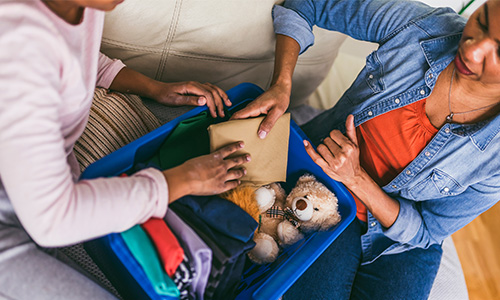
Decide What to Throw Away After a Fire
While some items in your home may look perfectly fine after a fire, there can be more damage than you realize. To avoid sitting on a broken couch or eating a contaminated piece of food, use this list to figure out what to throw away after a house fire.
7 Things to Throw Away After a Fire
What do you throw away after a house fire? Here are a few items we’ve deemed as “must toss” when you’re cleaning up your home.
1. Electrical Equipment
Don't use small appliances, entertainment equipment and other devices until they’ve been checked for water and heat damage. If you’re unsure about their condition, it’s better to toss them than risk starting another fire.
2. Burned Clothes
While it is possible to clean your clothes, it’s not always advisable. Smoke and soot contain chemicals that can irritate your skin via touch and your respiratory system when you inhale them. They may also smell from the chemicals used by firefighters, which are also harmful. If your clothes are burned, it’s better to just throw them out.
3. Large Textiles
Aside from clothes, other fabric materials like bedding, rugs, drapes and carpet can absorb the smells and chemicals of smoke, soot and firefighting chemicals. Because they can often be too large to effectively clean — especially if the entire item is compromised — it’s probably best to just get rid of them.
4. Furniture and Mattresses
Like clothes and other textiles, fabric furniture pieces and mattresses can hold onto smells and chemicals you might not be able to clean out. Not to mention they could be structurally compromised by the heat or flames. If you’re unsure about the condition of these large items in your home, tossing them is the safest answer.
5. Cosmetics and Toiletries
Makeup and other toiletries have chemicals and minerals that are affected by heat from the fire. While water and tools, like fire extinguishers, are effective at saving lives and homes, they contain contaminants and toxins that alter the composition of the products in your bathroom, even if you can’t see them. The safest option is to just toss all cosmetics and toiletries and buy new ones.
6. Medicine
The potency and effects of medication can be affected by heat, soot, smoke, water and the chemicals used by firefighters to extinguish the fire. Throw them away and ask your doctor for a prescription refill or buy new over-the-counter drugs.
7. Food Items
Even non-perishable food can be compromised in a fire. While some food, namely sealed and canned foods, may look okay after a fire, high heat from the flames can activate bacteria. And, of course, water and chemicals used to extinguish the fire can contaminate food.
Here’s a list of food items you should throw away after a house fire:
- Charred food.
- Open containers.
- Bulging or rusting cans.
- Food with fire extinguisher dust on it.
- Perishable food left at room temperature for too long.
- Anything you suspect came into contact with contaminants.
- Anything stored in permeable packaging like cardboard, cloth or thin plastic bags.
As long as your fridge and freezer stayed sealed and were not harmed by heat or toxins during the fire or firefighting process, the food inside can stay safe for up to four hours. Still, check the items inside and throw out the food if:
- It has an odd odor.
- The fridge smells smokey.
- Soot got inside the fridge.
- It smells or tastes off when you prepare it.
- The fridge lost power and the food has been above 40 degrees for over two hours.
- It was in the freezer and no longer feels cold and hard and there are no ice crystals.
Throw Away Damaged Items
When it comes to tossing burned or otherwise damaged items, you might have a large pile that needs to be thrown away. This might even include bulky furniture or items you've never tossed before. Consider renting a dumpster for easy disposal so that you can focus your energy on other areas of the home.
All of the items in the dumpster will go to the landfill to be disposed of as trash. Unfortunately, after a fire, even construction debris can’t be salvaged for recycling because the chemical makeup changes.

Safety Tip
Once your home is deemed safe to enter, make sure to wear protective clothing while working on repairs or cleaning. Cover your body with pants and long-sleeve shirts, and wear close-toed shoes with good grip. You should also wear safety goggles, work gloves and a face mask.
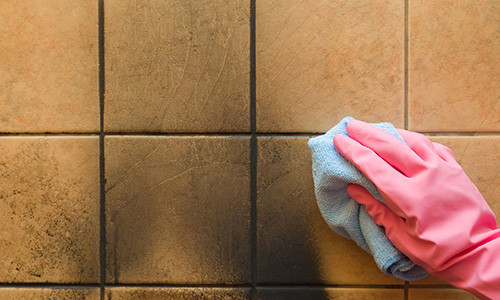
Start to Clean Your Home
Before you begin tackling the inside of your home, open all the windows and use fans to increase air circulation. This will help remove the smell of smoke and chemicals. Then, put on some gloves and use a shop vac to remove standing water leftover from firefighting efforts and pull up wet flooring like vinyl and carpet and dispose of them properly. If your carpet is not wet, just stained with soot, you can call a professional carpet cleaning service to lift the stain.
Next, take all wet items outside so you can assess the interior and begin cleaning. You can inspect these items later and decide whether they’re worth salvaging or should be tossed.
Inspect all interior surfaces for soot and clean them off. Don’t forget to check the ceiling. Then, make sure to get your heating, ventilating and air conditioning units and ductwork professionally cleaned. Change the filters when you first return to your home and every month for the next year to keep the air in your home clean.
Remove Smoke, Soot and Ash
Use this simple solution to clean the walls, furniture, floors, cabinets and other surfaces in your home:
- 2 tbsp dishwashing soap or laundry detergent
- 4-6 tbsp tri-sodium phosphate (TSP)
- 1 cup chlorine bleach or household cleaner
- 1 gallon of water
When cleaning surfaces and items in your home, be sure to wear gloves, use a sponge and rinse with clear water immediately.
If you still smell smoke after cleaning, make sure you thoroughly cleaned your HVAC ductwork, which could be holding onto odors. If the smell lingers after that, contact a restoration company about a cleaning procedure called thermal fogging. This will help release smoky odors trapped in the attic and wall insulation. The process involves chemical fog which neutralizes the smell.

Safety Tip
Products containing TSP can reduce odors in fabrics, but TSP can be harmful to your skin, so be careful.
Clean and Salvage Items After a House Fire
According to FEMA, the following actions should be taken:
- Wash all clothing before wearing.
- Wash and dust all household items.
- Disinfect and deodorize carpets, window coverings, upholstered furniture and mattresses with steam or another
appropriate cleaning solution, like the one above. - Do not use odor-masking spray.
Walls and Windows
Use the cleaning solution provided above to wash away soot and ash from walls and windows — the smokey smell will disappear. When cleaning walls, let them air-dry completely, about 24 to 48 hours, before repainting.
Washable wallpaper can also be cleaned using the solution above, but be sure not to get the wall wet behind the paper to prevent mold and mildew. Use a commercial paste to re-apply any loose edges or sections of the wallpaper.
Clothing and Other Fabrics
How do you get the smoke smell out of clothes after a house fire? The trick is to treat them ASAP. The longer you wait, the more stains and smells linger.
How to Remove Soot
To lift soot stains, use the crevice attachment on a vacuum before you get your clothes wet. This should remove most of the ash particles without adhering them to your clothes, curtains, rugs and other fabrics. While still dry, sprinkle baking soda on the stain to help absorb the soot, then vacuum it off after 15 minutes. Repeat this until the majority of the stain is removed.
How to Get the Smoke Smell Out of Clothing
For items that can handle bleach, put on gloves and protective clothing, and try this formula:
- 4-6 tsp of TSP
- 1 cup of bleach
- 1 gallon of water
Stir the ingredients completely and add the solution to your clothing, or apply it using a sponge to larger items like upholstered furniture and tapestries. Rinse with clean, clear water and let dry. Hang what you can outside and give larger items more time. Try using fans and opening windows if needed.
If you can’t or don’t want to use bleach, try soaking these items in warm water with detergent or white vinegar overnight. Rinse and repeat until the smell is gone.

Pro Tip
If you can’t get the soot stains or smoke smell out of your clothes, take them to a dry cleaner and ask them to be treated for smoke odors in addition to traditional dry-cleaning techniques. For other items, contact a professional cleaner or restoration company.
Furniture
If your furniture was not burned in the fire and is still safe to use, you might be able to salvage it. Hardwood furniture, in particular, can be easy to save. Clean it with oil soap you would use for hardwood floors and other wood items. For deeper stains, sand and refinish the furniture. Even if you’re able to remove the stains, you may want to take your furniture to a professional to make sure any lingering chemicals are removed.
Dishes
You may be asking yourself, is it safe to use dishes after a house fire? As long as your plates, pots, utensils and other kitchen items are thoroughly cleaned, they should be safe to use. However, plastic and wood dishes will likely need to be thrown out because smoke can be easily absorbed into these materials.
How to Clean Dishes After a Fire
Wash your dishes with hot water and soap as usual, then rinse in the following solution:
- 2 tbsp bleach
- 1 gallon of water
Non-Porous Surfaces and Floors
While materials like glass and metal are easier to save than fabrics, you shouldn’t keep anything that’s been burned, charred, melted or otherwise deemed structurally unsafe.
Glass will usually uphold in a fire and can be cleaned with vinegar and dish soap, or soaked in white vinegar and baking soda.
Metal may stain, but can usually withstand damage. Clean with vinegar and dish soap, then lightly sand and paint.
Hardwood floors are usually salvageable, unless they’ve been charred or have burn marks. Clean them using oil soap, then sand and refinish if needed.
How to Clean the Exterior of Your Home
Now that the inside is becoming more livable, you can focus on cleaning up the outside of your house. Starting from the top, check and clean your gutters, especially if there was damage to your roof. The gutters may be clogged with ash and other materials. Piles of ash can be thrown in your garbage, but consider double bagging to prevent dust clouds. Try to avoid dust clouds and washing ash down storm drains.
Next, wash the walls and windows. As you’re cleaning, be sure to work from top to bottom so that water and debris run down to uncleaned areas. Use a power washer to remove ash, soot and chemical fire retardants. If the damaged area is small, you may only need to use a stiff brush and a solution of water and borax. If firefighters used Class A foam in their efforts, you can take it off with a paint scraper. Tile cleaner will also remove any stubborn remnants. Wash windows with glass cleaner.
Remove solid debris from walkways and the driveway and use the power washer again to remove soot on these surfaces. Then, lightly water your yard with the garden hose for about a week to help ash recede into the ground.
Getting Back to Normal
Now you have all the tools you need to clean up after a house fire and get things back in order. The worst is behind you and, hopefully, with this guide, you’ll have the information you need to live comfortably in your home again.
Expert Contributors

Dan Morris
As an operations manager based at Dumpsters.com's primary location in Parma, OH, Dan streamlines the daily routes of our drivers and maintains relationships with landfills, transfer stations and sorting facilities throughout Northeast Ohio. Not only is he responsible for getting your dumpster delivered on time, but he also helps to maximize fuel efficiency and ensure debris is transported to the right location for responsible disposal.
What Do You Think?
Cleaning up after a disaster? We're listening. Head over to Twitter or Facebook,
and use #dumpstersblog to join the conversation.


